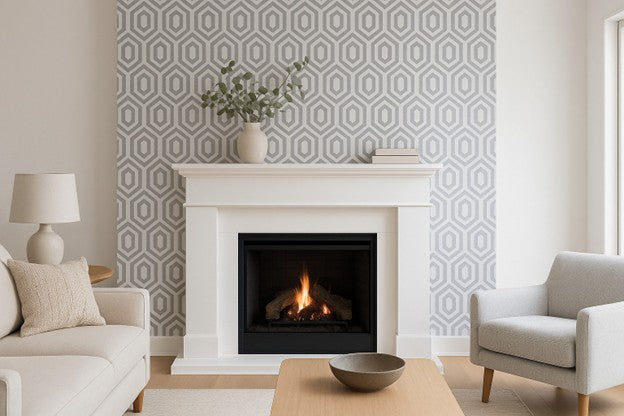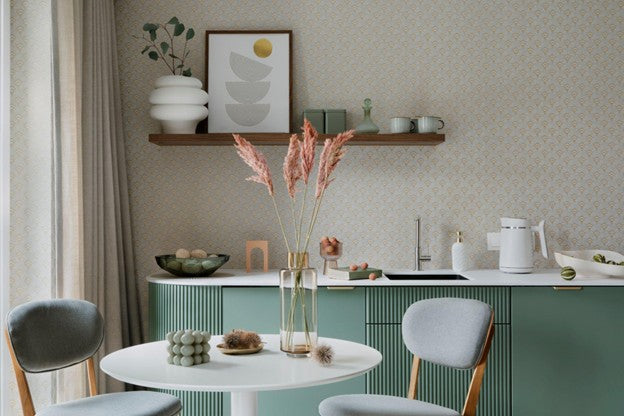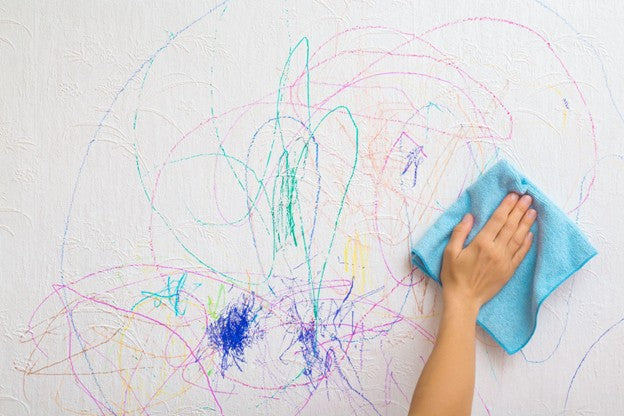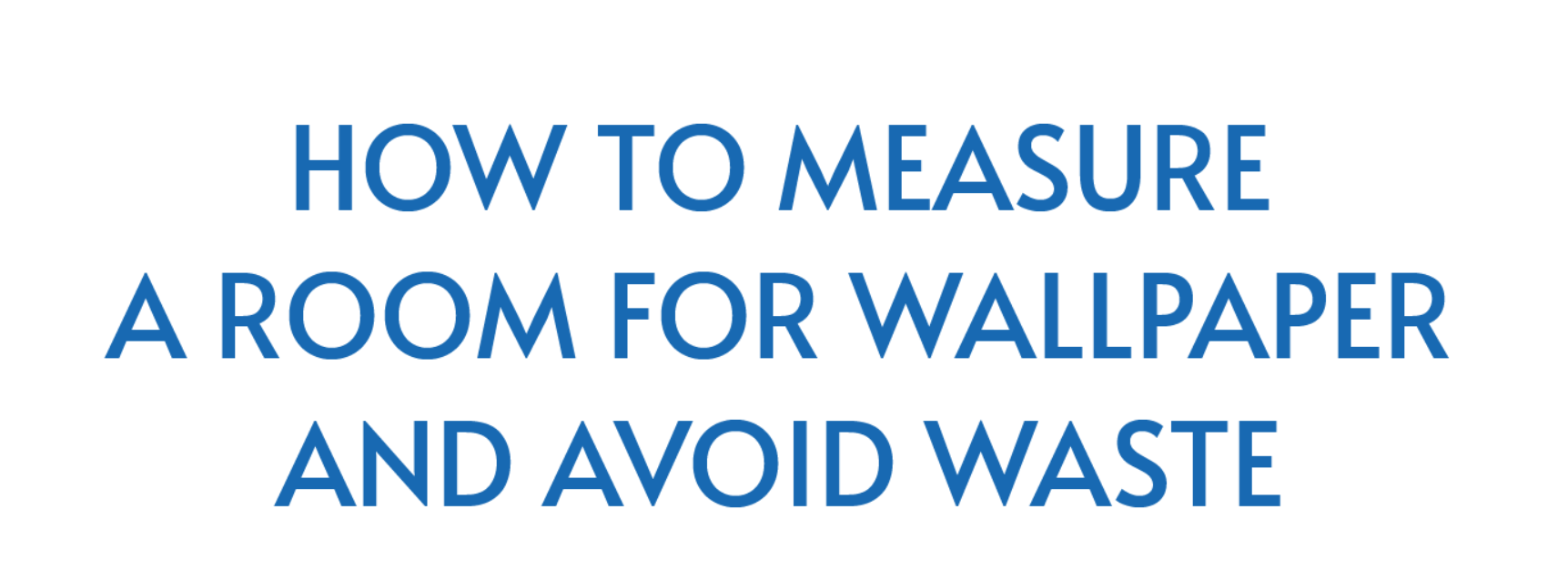Adding wallpaper to a kitchen backsplash is an easy way to transform the look of your space without the cost and permanence of tile. From bold patterns to subtle textures, today’s wallcoverings make it possible to create a designer look in just a few hours. That said, a kitchen backsplash is a high-moisture, high-splash area, and even the most durable backsplash wallpaper can wear out over time.
Although you can’t make wallpaper completely waterproof, by following some widely accepted strategies, you can extend its lifespan and keep it looking great. The key is choosing the right materials, using a high-quality wallpaper primer and adhesive, and following best practices for sealing and maintenance.

Choosing the Right Wallpaper
Not every wallcovering is suited for kitchen use. When selecting wallpaper for a kitchen backsplash, focus on durability and ease of cleaning. Vinyl, vinyl-coated, washable, and foil wallpaper are top choices because they’re moisture-resistant and can handle occasional wiping.
Peel-and-stick vinyl can be a good solution for renters—it’s easy to apply and remove without damaging the wall—but it may not last as long in high-splash areas. Avoid delicate or porous materials like grasscloth, which can absorb stains and degrade quickly.
Equally important is to follow the wallpaper manufacturer’s recommendations for installation. If they specify a particular type of wallpaper adhesive or application method, stick to it. This ensures proper bonding and helps you achieve the best possible finish.
Preparing the Backsplash Surface
A smooth, clean surface is essential for long-lasting results. Start by removing outlet covers and light switch plates from the backsplash area. Degrease the wall thoroughly, paying special attention to areas near the stove and sink where splashes and residue are common. Fill cracks, holes, and grout lines to create a flat working surface.
The type of surface you’re working with will determine the best wallpaper primer:
● Tile, laminate, or glass: Use a high-quality adhesion-promoting primer such as ROMAN PRO-935 to ensure the wallpaper bonds properly to non-porous surfaces.
● Bare drywall or plaster: ROMAN PRO-977 Ultra-Prime provides a water-resistant, smooth base and helps prevent the wallpaper from peeling.
Once the surface is primed, allow it to dry fully. Minimum drying time is about 3 hours before proceeding with wallpaper adhesive, but if you have the time, waiting overnight to ensure the primer completely dries is best. Always test a small, inconspicuous area before committing to the full installation to confirm the primer and adhesive combination works with your chosen wallpaper.

Selecting an Adhesive
Your choice of wallpaper adhesive is just as important as the wallpaper itself—especially in a kitchen backsplash, where moisture and steam can stress the bond. Always follow the wallpaper manufacturer’s instructions. If the guidance is general (“use any high-quality, premixed wallpaper paste”), ROMAN PRO-543 Universal is a strong option. This fully synthetic, polymer-based adhesive offers better resistance to rewetting than starch-based adhesives, which is valuable in a kitchen environment.
All ROMAN adhesives (and primers) contain biocides that can help resist the growth of mold and mildew on the adhesive film, although they won’t kill existing mold. In poorly ventilated areas, adhesives may still break down over time, so proper airflow remains important. Always avoid low-grade or expired pastes—they can compromise adhesion and shorten the life of your backsplash wallpaper.
After installation, allow adhesive to cure for at least 24 hours before applying any protective coating.

Installing Wallpaper on a Kitchen Backsplash
Follow these steps for a smooth, professional-looking installation:
1. Turn off power
- Shut off power to outlets and switches at the breaker box before removing covers.
- Confirm with a voltage tester before working around electrical components.
2. Prepare your wallpaper panels
- Measure the backsplash height and length.
- Cut panels slightly longer than needed so you can trim precisely after application.
3. Apply adhesive
- For traditional wallpaper, spread adhesive evenly on the back using a roller or brush.
- Follow the manufacturer’s booking instructions (folding paste-to-paste and allowing time for absorption).
- Peel-and-stick wallpaper skips adhesive but still requires careful handling. Try E-Z Hang Peel and Stick Helper to make positioning the paper a breeze.
4. Start from one side
- Begin at one corner of the backsplash and position the first strip carefully.
- Use a level to ensure the strip is straight before pressing it into place.
5. Smooth into position
- Use a wallpaper smoothing tool to remove air bubbles, working from the center toward the edges.
- Press firmly along seams to ensure a tight bond.
6. Work in sections
- Continue installing panels, matching patterns as you go.
- Slightly overlap the wallpaper under the outlet and switch plates for a clean finish.
7. Trim the excess
- Use a sharp utility knife to trim along countertops, cabinets, and other edges.
- Change blades often for clean cuts without tearing.
8. Reinstall hardware
- Replace outlet and switch covers, tightening screws just enough to hold them in place without buckling the wallpaper.
Always take your time with pattern alignment—especially between outlets and cabinetry—to ensure a professional look.

Protecting the Wallpaper (Waterproofing)
While we emphasize that no method will make kitchen wallpaper completely waterproof, some noted wallcovering manufacturers—such as Milton & King—recommend applying a flat, water-based varnish to add moisture resistance. Products like Polyvine Decorators Varnish or Modern Masters Varnish are often used by professional installers.
Apply 2–3 thin coats once the wallpaper and adhesive are fully cured, testing first on a spare piece to ensure there’s no discoloration or unwanted sheen. Most protective varnishes require 4–6 hours between coats and at least 24 hours to fully cure. (NOTE: ROMAN has not tested these products on wallcoverings and does not endorse any specific varnish.)
In addition to varnish, sealing the edges where wallpaper meets the countertop, sink, or adjoining walls with a clear silicone or acrylic caulk can help prevent water from seeping behind it. For high-splash or grease-prone areas, especially near cooktops, consider adding a tempered glass panel over the wallpaper for maximum protection.
These measures can significantly extend the life and appearance of your kitchen backsplash.
Maintenance and Longevity
Keeping your kitchen backsplash wallpaper in top shape requires a bit of ongoing care.
- Clean regularly – Wipe the backsplash wallpaper with a soft cloth or sponge and mild soap. Avoid abrasive scrubbers or harsh cleaners that could damage the surface or protective coating.
- Dry after cleaning – Always dry the wallpaper immediately after wiping to minimize moisture exposure.
- Inspect seams – Check periodically for lifting or curling. If you notice any, apply seam adhesive promptly to keep water from getting behind the wallpaper.
- Maintain ventilation – Use a kitchen ventilation system that provides at least 100 CFM per linear foot of cooktop or 15 air changes per hour to reduce steam and grease buildup.
- Protect high-use areas – Be extra vigilant near sinks and stoves, where moisture and splashes are more frequent.
Even with careful maintenance, expect that your backsplash wallpaper will eventually need replacement, especially in high-use zones near sinks and stoves. With proper care, however, it can last for years while maintaining its style and color.

ROMAN Products for Your Wallpaper Backsplash Project
A kitchen backsplash wallpaper installation is a simple, cost-effective way to bring new life to your cooking space. As always, you can trust ROMAN for the high-quality wallpaper accessories you need to ensure a successful installation.
While it’s not possible to create 100% waterproof wallpaper, measures such as varnish applications (as suggested by leading wallcovering manufacturers like Milton & King), careful sealing, and mindful maintenance can help protect it from daily kitchen wear.
With realistic expectations and the right products, you can enjoy the charm of high-grade wallpaper for a kitchen backsplash—transforming your space without the need for tile.
Recent Posts
-
How to Use Wallpaper to Create a Faux Brick Effect
read more >> -
Wallpapering Inside Closets & Pantries: A Fun Surprise Element
read more >> -
How to Install Wallpaper on a Fireplace Surround for a Bold Touch
read more >> -
How to Wallpaper a Kitchen Backsplash (and Waterproof It)
read more >> -
How to Remove Stains From Wallpaper Without Ruining It
read more >> -
How to Measure a Room for Wallpaper and Avoid Waste
read more >>







